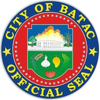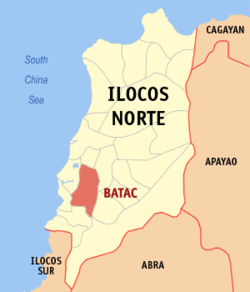- Batac
-
City of Batac
Ciudad ti Batac
Lungsod ng Batac— City — Batac Government Building South Wing 
SealNickname(s): Home of Great Leaders, City of my Dreams Map of Ilocos Norte showing the location of Batac. Location in the Philippines Coordinates: 18°03′N 120°34′E / 18.05°N 120.567°ECoordinates: 18°03′N 120°34′E / 18.05°N 120.567°E Country  Philippines
PhilippinesRegion Ilocos Region (Region I) Province Ilocos Norte District 2nd District Founded 1577 Barangays 43 Government - Mayor Jeffrey Jubal C. Nalupta Area - Total 161.06 km2 (62.2 sq mi) Population (2007) - Total 50,675 - Density 314.6/km2 (814.9/sq mi) Time zone PHT (UTC+8) ZIP Code 2906 Website batac.gov.ph Population Census of Batac Census Pop. Rate 1995 45,534 — 2000 47,682 0.99% 2007 50,675 0.84% Batac is a component city in the province of Ilocos Norte, Philippines. The town is located in the northwest corner of the island of Luzon, about 11.2 km from the eastern shores of the South China Sea. The municipalities of Banna, Currimao, Paoay, Pinili and San Nicolas form its boundaries.
According to the latest census, it has a population of 50,675 in 9,882 households.
Batac is known as the "Home of Great Leaders", as it is the hometown of many significant figures in the history of the Philippines. Among them is the former Philippine president Ferdinand Marcos. It is also the birthplace of Gregorio Aglipay, the founder of the Philippine Independent Church, better known as the Aglipayan Church, and Gen. Artemio Ricarte, the "Father of the Philippine Army".
Batac is well-known for being the home of the Mariano Marcos State University (MMSU), a high-degree granting university that has several branches throughout the province.
Contents
History
Batac is one of the oldest towns in Ilocos Norte. It was founded by the conqiustador Juan de Salcedo in 1577, shortly after he had consolidated Spanish rule in Vigan.[citation needed]
In the early 1867, the first site of the town of Batac was San Josef, now Brgy. Palpalicong. Two separate communities existed at the time. One was a Christian community headed by a chief called Captain Bazar, and the other a non-Christian community called "Itneg", headed by Captain Tagley, at Sitio Nagalisan, now a part of Brgy. Payao.[citation needed]
As Spain pushed further into the hinterlands, the non-Christians were converted and assimilated into the growing Christian community. The united communities grew into the town of Batac.[citation needed]
Cityhood
In 1998, Municipality of Batac qualified to become a city. Nine years later, Republic Act 9407, the law that converted the Municipality of Batac into a component city in the Province of Ilocos Norte, to be known as Batac City, was overwhelmingly ratified by the people in a plebiscite conducted on June 23, 2007.
However, Batac lost its cityhood, along with 15 other cities, after the Supreme Court of the Philippines granted a petition filed by the League of Cities of the Philippines, and declared the cityhood law (RA 9389) which allowed the town to acquire its city status, unconstitutional. The said cities, the court ruled, did not meet the requirements for cityhood, as mandated by Republic Act 9009, which increased the income requirements for prospective cities.
More than a year later, on December 22, 2009, acting on the appeal of the so-called "League of 16 Cities" (of which Batac is a part of), the Supreme Court reversed its earlier ruling as it ruled that "at the end of the day, the passage of the amendatory law (regarding the criteria for cityhood as set by Congress) is no different from the enactment of a law, i.e., the cityhood laws specifically exempting a particular political subdivision from the criteria earlier mentioned. Congress, in enacting the exempting law/s, effectively decreased the already codified indicators."[1] As such, the cityhood status of Batac is effectively restored.
August 27, 2010, Batac City in Ilocos Norte is now plain old Batac again. It shares the fate of 15 other cities, after the Supreme Court reinstated a 2008 decision declaring as “unconstitutional" the cityhood laws converting 16 municipalities into cities.[2]
A previous law required towns aspiring to become cities to earn at least P100 million annually, which none of the 16 did.
Voting 7-6, with two justices not taking part, the SC reinstated its Nov. 18, 2008 decision declaring as unconstitutional the Republic Acts (RAs) converting 16 municipalities into cities.
On February 2011, the supreme court upheld the cityhood of Batac and 15 other cities.
Origin of the town's name
The word "Batac" in a local dialect translates as "pull". More loosely, it refers to "the people's pulling their efforts together."[citation needed]
Batac has an interesting colloquial origin of its name. According to a legend, set in pre-settlement Batac, a man fell into a deep hole while he was digging for the root crop "camangeg". He struggled to get out but could not despite his best efforts. He cried for help but nobody was around. He waited for hours and had given up hope of being saved. Fortunately, two men from the neighboring town of Paoay happened to pass by. They heard the man shouting and traced it to where he was trapped. Upon seeing him, they heard the man say "Bataquennac! Bataquennac!" The two men did not understand until the man explained that he was saying, "Pull me up! Pull me up!" They did just that. When the two men reached their hometown, they told their story to their friends. Since then, the town has been called "Batac," which is derived from the word "bataquennac." but that is only a tale, the true origin of the Batac was named by the Batak tribe who exist five hundred years ago. Before the Spanish colonization. And the ancient tribe of Batak in Ilocos Norte is related to the Batak Tribe of Toba Lake In the province of North Sumatra Indonesia.
Geography
Batac City is located in the mid southwestern portion of the province of Ilocos Norte. It lies approximately within altitude 17º17’ north and longitude 120º28’ east. Its boundaries include the Municipality of San Nicolas on the north; Municipality of Sarrat on the northeast; Municipality of Marcos on the east-northeast; Municipality of Banna on the east; Municipality of Pinili on the southeast; Municipality of Currimao on the southwest; and the Municipality of Paoay on the west. It is about 472 kilometers north of Metro Manila, about 18 km. south of Laoag City, the capital of the province; 275 km. north of San Fernando City, the regional center of Ilocos Region and 11.2 km east of the eastern shore of South China Sea.
Travel time by motor vehicle at this time is very convenient because of well paved roads and is 15 – 20 minutes to Laoag City and 8 – 9 hours to Metro Manila.
Batac City has a total land area of 16, 101 hectares. The terrain of the municipality ranges from flat to rolling and hilly and to very steep. The broad valleys are mostly located in the poblacion with a slope of 0-8%. All the rural barangays except those in the eastern part have a slope of 0 -30%. There are various soil types that are poorly drained due to the heavy texture of most of the subsoil. There are two rivers that cut across Batac, the Quiaoit River (Pagdanuman) and the Garasgas River.
Batac City lies within the tropical rain forest climate zone (Köppenzone Af), and experiences two distinct seasons. From the later part of May to October is the wet season, with an annual average rainfall of 114.07 inches (PAG-ASA, 2000). The dry season lasts from November to April.
City Government Officials
Term of Office: June 30, 2010 - June 30, 2013
Mayor: Jeffrey Jubal C. Nalupta
Vice-Mayor: Ronald Allan M. Nalupta
Councilors:- Bismark Angelo A. Quidang
- Eugenia Violeta D. Nalupta
- Medeldorf M. Gaoat
- Bernardo K. Marders
- Florencio P. Laud
- Orlando C. Mangapit
- Mary Coleen Columbia L. Cajigal
- Avelard Ibarra F. Crisostomo
- Elmer D. Pungtilan
- Amable A. Abellon
ABC President: James Paul C. Nalupta
SK President: Jarius Mark D. NaluptaBarangays
Batac is politically subdivided into 43 barangays, 14 of which constitute the poblacion.
- Brgy.1-S, Valdez (Caoayan) (Pob.)
- Brgy.1-N, Ricarte (Nalasin) (Pob.)
- Brgy.2, Ablan (Labucao) (Pob.)
- Brgy.3, Cangrunaan (Pob.)
- Brgy.4, Nalupta (Suabit) (Pob.)
- Brgy.5, Callaguip (Pob.)
- Brgy.6, San Julian (Pob.)
- Brgy.7, Caunayan (Pob.)
- Brgy.8, Acosta (Iloilo) (Pob.)
- Brgy.9, Aglipay (Pob.)
- Brgy.10-S, Barani (Pob.)
- Brgy.10-N, Lacub (Pob.)
- Brgy.11 Ben-Agan (Pob.)
- Brgy.12, Palpalicong (Pob.)
- Brgy.13, Baay
- Brgy.14, Bungon
- Brgy.15, Baligat
- Brgy.16-S, Quiling Sur
- Brgy.16-N, Quiling Norte
- Brgy.17, Tabug
- Brgy.18, Magnuang
- Brgy.19, Pimentel (Cubol)
- Brgy.20-S, Mabaleng
- Brgy.20-N, Colo
- Brgy.21, Quiom
- Brgy.22, Maipalig
- Brgy.23, Bininggan
- Brgy.24, Sumader
- Brgy.25-N, Camguidan
- Brgy.25-S, Payao
- Brgy.26, Parangopong
- Brgy.27-E, Capacuan
- Brgy.27-W, Naguirangan
- Brgy.28, San Mateo
- Brgy.29, San Pedro
- Brgy.30-E, Baoa East
- Brgy.30-W, Baoa West
- Brgy.31, Camandingan
- Brgy.32, Palongpong
- Brgy.33-S, Rayuray
- Brgy.33-N, Nagbacalan
- Brgy.34, Dariwdiw
- Brgy.35, Bil-loca
Tourism
- Marcos Museum
- Aglipay Shrine
- Ricarte Park and Shrine
- Batac Riverside Empanadaan
- Immaculate Conception Parish
- Plaza Maestro Complex
- Batac Mini Park
- Batac City Hall
- Mariano Marcos State University
- Farmers Festival - celebrated every May.
- Empanada Festival - celebrated every June 23rd, the charter day of Batac.
- City Fiesta - celebrated during the month of December - a one month long celebration
People from Batac City
- Gregorio Aglipay
- Artemio Ricarte
- Rodolfo Biazon
- Aquilino Pimentel, Jr.
- Ferdinand E. Marcos
References
External links
- Official Website of Batac
- Official Facebook Page of Batac
- Philippine Standard Geographic Code
- 1995 Philippine Census Information
- 2000 Philippine Census Information
- 2007 Philippine Census Information
Municipalities Component cities Batac • Laoag Cities of the Philippines
Cities of the PhilippinesHighly-urbanized Cities Angeles · Bacolod · Baguio · Butuan · Cagayan de Oro · Caloocan · Cebu · Davao · General Santos · Iligan · Iloilo · Lapu-Lapu · Las Piñas · Lucena · Makati · Malabon · Mandaluyong · Mandaue · Manila · Marikina · Muntinlupa · Navotas · Olongapo · Parañaque · Pasay · Pasig · Puerto Princesa · Quezon City · San Juan · Tacloban · Taguig · Zamboanga
Independent
Component CitiesComponent Cities Alaminos · Antipolo · Bago · Bais · Balanga · Batangas · Batac · Bayawan · Baybay · Bayugan · Biñan · Bislig · Bogo · Borongan · Cabadbaran · Cabanatuan · Cadiz · Calamba · Calapan · Calbayog · Candon · Canlaon · Carcar · Catbalogan · Cauayan · Cavite · Danao · Dapitan · Dasmariñas · Digos · Dipolog · Dumaguete · El Salvador · Escalante · Gapan · Gingoog · Guihulngan · Himamaylan · Iriga · Isabela · Kabankalan · Kidapawan · Koronadal · La Carlota · Lamitan · Laoag · Legazpi · Ligao · Lipa · Maasin · Malaybalay · Malolos · Marawi · Masbate · Mati · Meycauayan · Muñoz · Naga, Cebu · Oroquieta · Ozamiz · Pagadian · Palayan · Panabo · Passi · Roxas · Sagay · Samal · San Carlos, Negros Occidental · San Carlos, Pangasinan · San Fernando, La Union · San Fernando, Pampanga · San Jose · San Jose del Monte · San Pablo · Santa Rosa · Silay · Sipalay · Sorsogon · Surigao · Tabaco · Tabuk · Tacurong · Tagaytay · Tagbilaran · Tagum · Talisay, Cebu · Talisay, Negros Occidental · Tanauan · Tandag · Tangub · Tanjay · Tarlac · Tayabas · Toledo · Trece Martires · Tuguegarao · Urdaneta · Valencia · Victorias · Vigan
Categories:- Municipalities of Ilocos Norte
Wikimedia Foundation. 2010.



